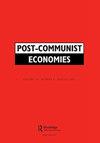越南的工会和工人福利
IF 1.8
3区 经济学
Q2 ECONOMICS
引用次数: 0
摘要
摘要工会在劳动力市场中的作用目前是越南的一个热门话题,因为越南计划从单一的国家主导的工会体系过渡到允许某些类型的独立工会参与的新体系。本研究利用越南国家代表性数据集提供了工会覆盖率与工人福利之间联系的第一个证据。采用仪器变量技术进行估计。通过使用横截面数据,该研究发现,工会覆盖在收入和劳动力供应方面对两性都产生了负面影响,同时对他们参与社会保险产生了积极影响。然而,在调查非国有部门时,就收入而言,对妇女的影响消失了,就劳动力供应而言,对两性的影响也消失了。该研究还显示了使用面板数据的一些重要结果。关键词:工会工人福利收入工作时间社会保险披露声明作者未发现潜在的利益冲突在本研究中,我们分别使用STATA的IVREG2和XTIVREG2命令进行IV估计和IV- fe估计。对于二进制结果(例如社会保险参与),我们也使用这些命令,因为IVPROBIT命令只与连续的内生协变量一起工作,而像IVLOGIT这样的命令不存在。对于每个波,VLFS都是按照2-2-2旋转的方式设计的。连续两个季度对一个家庭进行调查。之后,该指数将被连续两个季度暂时排除在调查之外。接下来的两个季度将再次接受调查。因此,我们可以从2018年的VLFS浪潮中构建两个周期的短面板数据样本。样本中的每个工人都被观察了两次。在该年度上半年对该工人进行的第一次观察视为在第一期进行。在该年下半年对同一名工人进行的第二次观察,会被视为在该年第二期进行(即部分样本在该年第II季被观察两次,第一次在该年第III季被观察,第二次在该年第III季被观察)。其余的样本也被观察了两次,第一次是在第一季度观察到的,第二次是在当年的第四季度观察到的。对于分位数固定效应估计,我们不能使用STATA的XTQREG命令,因为它只适用于大量的周期,而我们只有两个周期的短数据面板。因此,我们使用QREGPD进行估计。本文章由计算机程序翻译,如有差异,请以英文原文为准。
Trade unions and workers’ welfare in Vietnam
ABSTRACTThe role of trade unions in the labour market is currently a hot topic in Vietnam as there is a plan to transition from a single state-led union system to a new system that allows the participation of some types of independent unions. This study provides the first evidence on the links between union coverage and workers’ welfare utilising a Vietnamese national representative dataset. An instrument variable technique is applied for estimation. Using cross-sectional data, the study finds that union coverage negatively affects both sexes in terms of earnings and labour supply while positively affecting their participation in social insurance. However, the effects disappear for women in terms of earnings and for both sexes in terms of labour supply when investigating the non-state sector. The study also shows some important results using panel data.KEYWORDS: Trade unionworkerwelfareincomework hourssocial insurance Disclosure statementNo potential conflict of interest was reported by the authors.Notes1. In this study, we use the commands IVREG2 and XTIVREG2 of STATA for IV estimations and IV-FE estimations, respectively. For binary outcome (e.g. social insurance participation), we also use these commands because the IVPROBIT command works with continuous endogenous covariates only and a command like IVLOGIT does not exist.2. For each wave, VLFS is designed on a 2-2-2 rotation basis. A household is surveyed for two consecutive quarters. It is then temporarily excluded from the survey for another two consecutive quarters. It is surveyed again in the next two quarters. Therefore, we can construct a short-panel data sample with two periods from the 2018 wave of VLFS. Each worker in the sample was observed twice. The first observation of the worker conducted in the first half of that year is considered to be made in the first period. The second observation of the same worker conducted in the second half of that year is considered to be made in the second period (i.e. a part of the sample were observed twice, the first observed in Quarter II and the second observed in Quarter III of that year. The rest of the sample were also observed twice, the first observed in Quarter I and the second observed in Quarter IV of that year).3. For quantile fixed effect estimation, we cannot use XTQREG command of STATA because it works only with a large number of periods while we has only a short panel of data with two periods. Therefore, we use QREGPD for the estimations.
求助全文
通过发布文献求助,成功后即可免费获取论文全文。
去求助
来源期刊

Post-Communist Economies
ECONOMICS-
CiteScore
4.90
自引率
18.20%
发文量
21
期刊介绍:
Post-Communist Economies publishes key research and policy articles in the analysis of post-communist economies. The basic transformation in the past two decades through stabilisation, liberalisation and privatisation has been completed in virtually all of the former communist countries, but despite the dramatic changes that have taken place, the post-communist economies still form a clearly identifiable group, distinguished by the impact of the years of communist rule. Post-communist economies still present distinctive problems that make them a particular focus of research.
 求助内容:
求助内容: 应助结果提醒方式:
应助结果提醒方式:


